|
HINDU and JAIN TEMPLES at
|

|
HINDU and JAIN TEMPLES at
|

Although the capital of the Charkya Dynasty was Badami, the royal family preferred Pattadakal, making it the city of coronations. The most magnificent among the numerous temples in this ruined city is the Virupaksha Temple, which was constructed under orders of queen Loka Mahadeva in the 8th century to commemorate the king’s triumphant return from the victorious campaign against the Pallava Dynasty. In the extant temples in this site can be seen the integration of experiences and techniques of masons and sculptors brought from various territories of the kingdom in south India. Pattadakal, which has miraculously survived destruction, is an example of the ‘Temple Cities’ of medieval India. It is also known as the place of coexistence of temples in both the Southern Style and Northern Style. |
|
It was in the 6th century that the powerful Charkya Dynasty was established, making Badami the capital, and having an extensive domain in the Deccan. It waged a number of fatalistic great wars with its mortal enemy, the Pallava Dynasty.
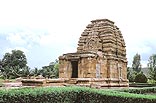
The battle for hegemony between the Charkya and Pallava Dynasties continued for ages. When the capital Badami was temporarily seized, the Charkyans had to retreat to the Deccan, making the town of Pattadakal, 30km away from Badami, its new operational base for the royal family. Among Charkyan cities, Badami and Aihole have a lot of early works of medieval architecture, while the temples in Pattadakal are from its mature period of the Charkya Dynasty and would strongly influence the temple architecture of east and middle India. In the middle of the 8th century, 10 years after the construction of the great temples in Pattadakal, the Charkya Dynasty, which had ruled this region for 200 years, was eventually destroyed by the Rashtrakuta Empire.
It was for the commemoration of the overwhelming victory of Vikramaditya II (r.733-744) in the war against the Pallava Dynasty that queen Loka Mahadeva ordered the construction of the conspicuously grand Virupaksha Temple. This temple was called Lokeshvara Temple at the outset, after the queen’s name, and was dedicated to Virupaksha (Shiva).
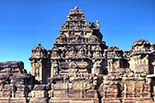  Virupaksha Temple and Mallikarjuna Temple
The Malikarjuna temple behind the Vidrupaksha Temple was built in a similar style and on a little smaller scale than the latter. Malikarjuna was also erected to commemorate the King’s victory in war, but on his second queen’s order.
The victor Vikramaditya II did not have compassion on the defeated Pallava people, but he was deeply impressed by the excellence of Pallava architecture. An epigraph says that he invited back an architect by the name of Gunda after returning home and gathered together a lot of masons and craftsmen from south India. The Virupaksha Temple has a hypostyle Mandapa in front of the Vimana, adding an entrance porch to each doorway of the three sides of the Mandapa. Its outer walls, partitioned by pilasters, have niches and windows alternately. Every niche, surmounted with the gable of intertwined chaitya windows, exhibits a well-carved statue. This wall system is harmonized with its upper tower part of the Vimana in the southern style, articulated in three stories.

Pattadadkal, whose name may mean the ‘town of a ruby-red crown’, was used by the Charkyans to hold coronation ceremonies since before the construction of the Virupaksha Temple. Now, it is a small village only embracing medieval stone temples, somewhat dilapidated, consisting of eight large, and some smaller, Hindu temples and a lot of small shrines built in the 7th and 8th centuries. At some distance from the Hindu group, there is also a Jain temple, which was erected about a century after, in the age of the Rashtrakuta Dynasty. Uniquely the front half of a pair of large elephants on both sides of the entrance doorway to its Garbhagriha (sanctuary) is sculpted in projection from the walls of the Mandapa.
Hindu temples in Pattadakal were all dedicated to Shiva. The three great temples (Virupaksha, Mallikarjuna, and Sangameshwara) are clearly in the southern Indian style, while the other five temples (Galaganatha, Kashivishvanatha, Jambhulinga, Kadasiddheshvara, and Papanatha) have towers resembling ‘Shikhara’ in the later northern Indian style.
 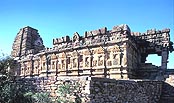 Elephanat sculpture and Papanatha Temple There exists, a short distance south, away from the area of the group of temples, another temple dedicated to Papanatha (Shiva), a god exterminating wickedness. Though it was first constructed in the form of ‘Garbhagriha plus Mandapa’ in around 720, a broader Mandapa was later added in front of them, making the entire length more than 28m. It eventually contained the statue of Nandi, which had originally been set in the open air, facing the older Mandapa. The outer walls of the Papanatha Temple are partitioned with pilasters, into which were set niches surmounted with the gable of intertwined chaitya windows for each partition. Every niche has a fine scene carved in relief from the “Ramayana” or “Mahabharata.” The sanctuary, surrounded with circumambulatory passages, is surmounted by a high tower. Though the Amalaka, a crown stone with vertical grooves, has been lost, the entire shape of the tower is a ‘Shikhara’ in the northern Indian style, emphasizing vertical lines. But a row of miniature shrines in the southern Indian style is set on the circumferential parapets, showing the undifferentiated coexistence of the styles of south and north India.
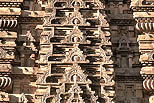
One can enter the precincts of the group of temples through two entrances, one on the northwest and one on the southeast. The temples stand in line from the north to south nearly in historical order and from smaller temples to larger ones. The dilapidated small shrines standing to the east and west of this line were also erected in the early Charkyan Style.
The southeastern entrance to the temple area by the Malprabha River also has a gate to the Virupaksha Temple. When entering the temple precinct, one initially looks toward a Nandi Shrine facing the Vimana. It is an open Mandapa made of greenish stone by royal craftsmen, well balanced in scale with the colossal Vimana.
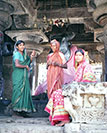
Like the cave temples in Badami, the temples in Pattadakal were saved from Muslims destruction with the result that Pattadakal has kept its spectacular view as a mediaeval ‘Temple City’ until now. The monuments are left serenely in a beautiful landscape surrounded with reddish limestone rock hills. It is quite interesting to see the coexistence of the early southern and early northern styles of temple architecture here. (In "UNESCO World Heritage" vol. 5. 1997, Kodan-sha ) |